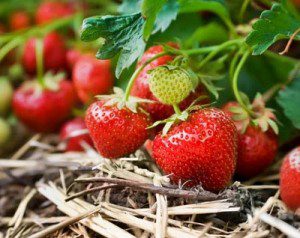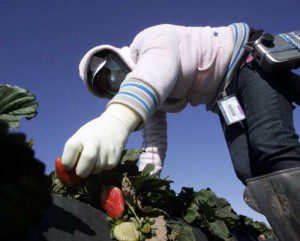
30 Mar EARTH MATTERS: STRAWBERRIES
Editor’s Note: This is another installment of a weekly series by the team of scholars/dynamic enviro-activists Anna Zivian and Billy Mason. Both have deep ties to Telluride, but have gone out into the world to make a difference. They are.
 Strawberries may just have gotten a little bit safer. For you, for farmworkers, and for the environment. Last week, Arysta LifeScience of Japan, makers of Midas, a methyl iodide-based fumigant, announced that they would pull methyl iodide from the market.
Strawberries may just have gotten a little bit safer. For you, for farmworkers, and for the environment. Last week, Arysta LifeScience of Japan, makers of Midas, a methyl iodide-based fumigant, announced that they would pull methyl iodide from the market.
Methyl iodide is an extremely toxic pesticide. By nature, all pesticides are toxic to something (otherwise they would not kill pests), but methyl iodide is particularly noxious. The Pesticide Action Network North America (PANNA) notes that it is linked to cancer, brain damage, and miscarriages, and that “[h]umans exposed to methyl iodide experience dizziness, sleepiness, nausea, diarrhea, slurred speech, lack of coordination, muscle convulsions – and in some cases, pulmonary edema.”
Arysta had been promoting methyl iodide as a replacement for methyl bromide, which is being phased out under an international treaty, the Montreal Protocol on Substances That Deplete the Ozone Layer. Conventional strawberry farmers in particular are heavy users of methyl bromide, which they apply as a fumigant to treat the soil before planting strawberries. In the process, much of the chemical escapes and harms farmworkers and neighboring communities as well as the ozone layer. Methyl iodide was approved for use in California – which accounts for 90% of US strawberry production – in 2010 in anticipation of the methyl bromide, phased-out, even though the panel making the decision noted serious problems with the product, with the panel’s chair calling it “one of the most toxic chemicals on earth.” Washington State actually did ban its use, basing that decision on California’s review.
Remarkably, the EPA itself has not (yet) banned the use of methyl iodide, despite a massive outcry from farmers, environmental organizations, and the public (including over 200,000 comments to the EPA in May 2011 urging a ban). Similarly, the EPA did not ban methyl bromide – it is being phased out because it depletes ozone, not because it causes harm to environmental or human health. In addition, several other countries allow its use.
But the corporation that produces methyl iodide decided to self-regulate in advance of any agency action, making the decision to pull methyl iodide from the market. I have not yet found a similar example of a company essentially deciding its own product was just too toxic though admittedly, that’s not what the company is saying.
The company claims there would be no market for the product. A lack of market has, in fact, been a reason for a big agricultural product corporation – Monsanto – to decide not to pursue production of genetically modified wheat. (Farmers have made it clear that they don’t want it, although that hasn’t stopped other companies like Syngenta from stepping into the void and working on drought-tolerant GM wheat, and Monsanto’s hold on plans to develop GM wheat is only temporary.) In this case, however, conventional strawberry farmers are anxious for something, anything to replace methyl bromide, and methyl iodide seemed like it could fit the bill.
Because so many different groups opposed it, though, methyl iodide is off the table. County commissioners, farmworkers, organic farmers, scientists, parents, environmental activists, and members of the public offered vocal opposition at a variety of fora. In addition, a group of environmental organizations had filed a suit in response to California’s 2010 approval of the pesticide. Action on a number of different fronts, in this case, did have an on-the-ground positive effect.
What would be best, of course, is a shift to sustainable production practices. A final deadline for phase-out of methyl bromide is not set, and growers can still use it on an annual approval basis. Strawberries always make lists of top fruits and vegetables to buy organic – according to PAN’s “What’s on my food?” project, the USDA Pesticide Residue Program has found over 50 different pesticides on strawberries. Farm workers working in conventional strawberry fields suffer terrible health problems. In other words, the facts are far less idyllic than the lyrics of the Beatles’ song suggest, and struggles to improve farm worker safety are continual and ongoing. But the fact that methyl iodide won’t be available is a good step, as is the growth in the market for organic strawberries.
And better yet, springtime is on its way and locally- and organically-grown strawberries are going to be hitting farmers’ markets soon.
Photo credits: An Oxnard resident picks strawberries at that city’s Cambry Farms. Credit: Los Angeles Times
Photo of strawberries: iStockphoto/Margarita Borodina) via http://coolsciencenews.blogspot.com/2010_08_29_archive.html



Sorry, the comment form is closed at this time.